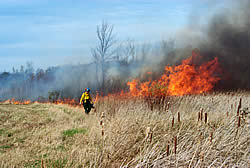
National Fire Plan Success Story
Midwest and Northeast Regions Study Prescribed Fire to Control Cattails
Iroquois National Wildlife Refuge, New York
National Fire Plan - Fuels Reduction

Burning cattails in Knowlesville Marsh. Photo courtesy USFWS, Iroquois National Wildlife Refuge.
To determine the effects of prescribed fire on controlling cattail growth, U.S. Fish and Wildlife Midwest and Northeast regional offices conducted a prescribed fire in a 30-acre area of cattails on the Knowlesville Marsh, located on the Iroquois National Wildlife Refuge in upstate New York. This burn in October 2007 was the second of two conducted on Iroquois during this study, which involves four national wildlife refuges and one wetland management district. Firefighters from Iroquois, Sunkhaze Meadows, Moosehorn and Long Island National Wildlife Refuges participated in the study. The project was a partnership between the two FWS regional offices and the USGS.
The goal of the study is to show whether burning cattails during its growing or dormant season makes a difference in its regrowth. This particular burn was conducted during the cattail's dormant season. Controlling cattails is important to the ecosystem health of the marsh. If they are not kept in check, they take over and create a stand of dense vegetation that is not useful to wildlife. In addition, prescribed burns allow the marsh mud flats to be exposed, helping native vegetation seeds to germinate which benefits wetland-dependent wildlife.
Five hours after the start of the event, the fire was fully ignited and by noon the next day was officially declared out. Nearly all the cattail biomass and other types of vegetation were consumed, but it appeared the cattail root system was only partially penetrated due to the moist conditions that had been created by a mid-October rain.
More samples will be collected in 2008 and compared to these samples and samples previously collected during a 2006 refuge summer burn during the cattail's growing season. The goal is to collect information that will help improve the way refuges use fire to control cattails.